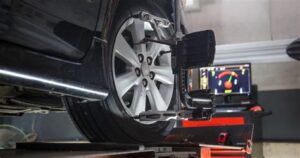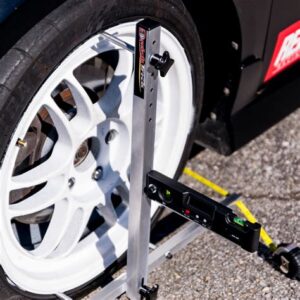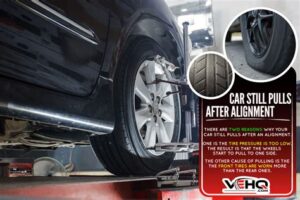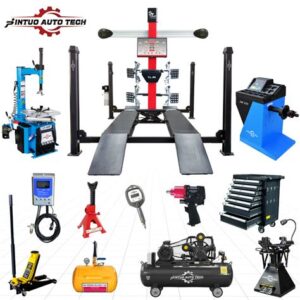In the world of classic cars, every detail matters, and proper wheel alignment is crucial for preserving the integrity and performance of these timeless vehicles. Classic car enthusiasts understand that maintaining these automotive treasures requires attention to every component, especially the wheels. This article delves into the significance of classic car wheel alignment, helping you recognize the signs that your cherished vehicle might need adjustment. We’ll provide a step-by-step guide to achieving optimal alignment, explore how it can enhance your car’s performance, and share essential maintenance tips to keep your classic car in pristine condition. Whether you’re a seasoned collector or a first-time owner, understanding wheel alignment is vital to ensure your classic car remains as enjoyable and exhilarating to drive as it was when it first hit the road.
Understanding The Importance Of Classic Car Wheel Alignment
Maintaining the alignment of your classic car is vital for ensuring optimal performance, safety, and longevity. Proper wheel alignment affects how your vehicle handles and wears over time. When the tires are aligned correctly, it leads to improved steering response, increased fuel efficiency, and reduced tire wear.
One key reason for maintaining alignment in your classic car is safety. Misaligned wheels can cause the car to pull to one side, making it more challenging to control, particularly at high speeds. This instability can pose risks not only to the driver and passengers but also to other road users.
Furthermore, a well-aligned vehicle promotes even tire wear. When your wheels are aligned properly, the tires make consistent contact with the road surface. This contact reduces the chances of uneven wear patterns that can lead to premature tire replacement and potentially costly repairs.
In addition to safety and tire longevity, proper alignment contributes to overall performance. A classic car is often a labor of love, and keeping it in peak condition enhances the driving experience. Many enthusiasts seek to not only preserve the appearance but also the performance characteristics of their vehicles, making alignment a crucial aspect of maintenance.
Regular checks on wheel alignment can also save money in the long run by reducing fuel consumption. Poorly aligned wheels create more drag, requiring more energy (and fuel) to maintain speed, which is especially noticeable in classic cars with less advanced engineering compared to modern vehicles.
In essence, understanding the importance of wheel alignment in your classic car transcends mere aesthetics; it is a fundamental element of responsible vehicle ownership that enhances performance, safety, and overall enjoyment of your driving experience.
Common Signs Your Classic Car Needs Wheel Alignment
Maintaining the integrity and performance of your classic car is crucial, and one of the primary aspects to monitor is wheel alignment. Knowing when your vehicle requires alignment can prevent further wear on tires and suspension components. Here are some common signs indicating that your classic car may need a wheel alignment:
- Uneven Tire Wear: If you observe more wear on one side of the tires compared to the other, it’s a clear sign that your wheels may be misaligned.
- Vehicle Pulling to One Side: When driving straight, if your classic car tends to drift left or right, it could signal that the wheels are out of alignment.
- Off-Center Steering Wheel: If your steering wheel is not centered when driving straight, it suggests the need for alignment.
- Vibration in the Steering Wheel: Unusual vibrations, particularly at certain speeds, can indicate alignment issues or other problems with the suspension system.
- Driveability Problems: General instability or challenges in handling could point to alignment discrepancies affecting your classic car.
Recognizing these signs early can save you from costly repairs and ensure that your classic car remains a joy to drive.
Step-By-Step Guide To Classic Car Wheel Alignment
Achieving proper wheel alignment in your classic car is essential for optimal performance, tire longevity, and overall driving safety. Here is a comprehensive step-by-step guide to aligning your classic car’s wheels effectively:
- Gather the Necessary Tools: Start by collecting the required tools: a tape measure, a level, a jack, jack stands, a wrench set, and an alignment tool or string.
- Prepare the Vehicle: Park your classic car on a flat, level surface. Ensure that the tires are inflated to the recommended pressure and that the steering wheel is centered.
- Check Before Adjusting: Measure the current toe settings by measuring the distance between the front and back of the tires on both the left and right sides. This will give you a baseline for adjustment.
- Adjust the Toe Angle: If your measurements indicate that your classic car‘s wheels are not parallel, adjust the tie rods to bring them into the correct toe angle. This is typically set with slight toe-in (around 1/16 to 1/8 inch).
- Set the Camber Angle: Check the camber angle by using a level against the wheel at a 90-degree angle. Adjust the upper control arms if the camber is not within the manufacturer’s specifications, aiming for a slight positive camber.
- Check the Caster Angle: This is usually not adjustable on classic cars, but it’s important to note the caster angle for reference. Ideally, it should be positive, which helps with the vehicle’s directional stability.
- Final Measurements: Once all adjustments are made, recheck the toe, camber, and caster measurements to ensure everything is within acceptable ranges.
- Test Drive: After completing the alignment, take your classic car for a test drive. Pay attention to how it handles, whether the steering feels centered, and if the car tracks straight.
- Regular Maintenance: Schedule regular inspections and alignments to keep your classic car performing at its best. Environmental factors and driving conditions can alter alignment over time.
Following this step-by-step guide will help you maintain the alignment of your classic car and ensure a smoother, safer driving experience.
How Proper Wheel Alignment Enhances Classic Car Performance
Ensuring classic car wheel alignment is crucial not only for safety but also for optimizing vehicle performance. When the wheels of a classic car are properly aligned, several significant benefits can be observed.
First and foremost, proper alignment improves tire wear. Misaligned wheels cause uneven tire wear, leading to a shorter lifespan for your tires. This not only incurs additional costs but also can affect the handling of your classic car. Regular alignment checks help maintain even tire wear, extending tire life and promoting better performance.
Furthermore, when the wheels are aligned correctly, it enhances the handling characteristics of your classic car. You’ll experience improved stability during rides, making it easier to steer and maneuver. This is particularly important when driving classic cars, which often have unique handling traits compared to modern vehicles.
Another benefit of proper wheel alignment is better fuel efficiency. Misalignment can cause your classic car to work harder to maintain speed, leading to increased fuel consumption. By ensuring your wheels are aligned, you minimize resistance, allowing for a more economical drive.
Proper alignment contributes to overall safety. With better handling and tire wear, the risk of accidents decreases significantly. A classic car that performs reliably not only provides peace of mind but also enhances the overall driving experience.
Regular checks and adjustments of your classic car wheel alignment are essential for performance optimization, cost savings, and safety on the road.
Maintaining Your Classic Car: Alignment Tips And Best Practices
To ensure your classic car remains in top condition, paying attention to wheel alignment is crucial. Proper maintenance not only extends the life of your vehicle but also enhances its performance. Here are some essential tips and best practices for maintaining your classic car’s wheel alignment.
- Regular Inspections: Schedule routine checks of your classic car’s alignment, especially after significant mileage or encountering rough roads.
- Tire Maintenance: Keep your tires well-maintained. Check the tire pressure regularly and inspect for uneven wear, as this can indicate alignment issues.
- Suspension Checks: Ensure that your suspension system is in good condition. Worn-out components may affect alignment and overall handling.
- Aligned Alignment Settings: Utilize factory specifications for wheel alignment settings specific to your classic car. Precision is key for optimal performance.
- Professional Help: Consult with a professional mechanic who specializes in classic cars. Their expertise can provide insights that regular shops may overlook.
- Documentation: Keep records of alignment services and any related repairs. This documentation will help track the car’s maintenance history and inform future care decisions.
- Drive Carefully: Be mindful of how you drive. Avoid sudden maneuvers and potholes that could jolt your alignment out of place.
By following these alignment tips and best practices, you not only maintain the functionality and appearance of your classic car but also ensure a smoother driving experience for years to come. Remember, a well-aligned vehicle is a joy to drive and will keep your classic car performing at its best!
Frequently Asked Questions
What is wheel alignment and why is it important for classic cars?
Wheel alignment refers to the angle and direction of the wheels in relation to the vehicle and the road. It is crucial for classic cars to ensure proper handling, tire wear, and overall vehicle performance.
How frequently should I get the wheel alignment checked on my classic car?
It’s recommended to have the wheel alignment checked at least once a year or whenever you notice uneven tire wear, after hitting a pothole, or if the steering wheel is off-center.
What symptoms indicate that my classic car might need a wheel alignment?
Common symptoms include uneven or rapid tire wear, the car pulling to one side, a crooked steering wheel, and vibrations while driving.
Can I perform a wheel alignment on my own for my classic car?
While some basic checks can be done at home, a proper wheel alignment requires specialized equipment and expertise. It’s best to take your classic car to a professional who understands vintage vehicles.
What impact does wheel alignment have on fuel efficiency for classic cars?
Improper wheel alignment can cause increased rolling resistance, leading to lower fuel efficiency. Keeping your wheels aligned will help maximize fuel economy.
Are there specific alignment specifications for different classic car models?
Yes, different classic car models have unique suspension designs and specifications. It’s essential to refer to the manufacturer’s guidelines or consult with a professional for the correct alignment settings.
What type of maintenance should be done alongside wheel alignment for classic cars?
Along with wheel alignment, regular tire rotation, brake checks, and suspension inspections are essential. Ensuring that your suspension and steering components are in good condition will help maintain proper alignment.





